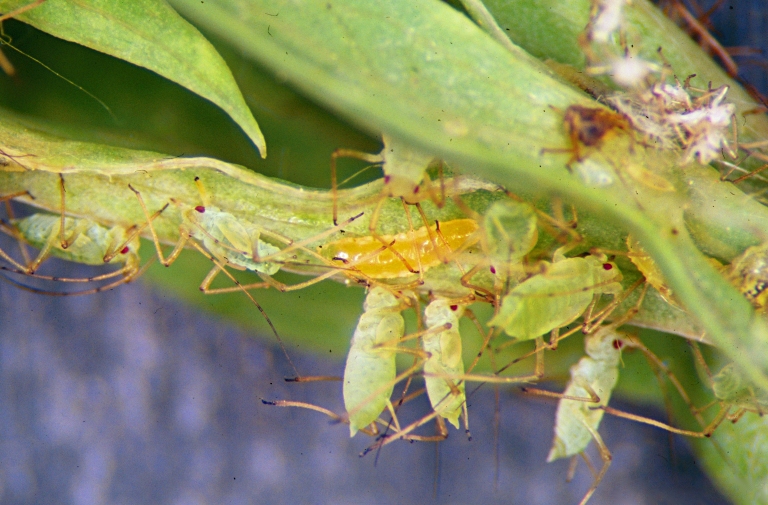Good Bug or Bad Bug?
Did you know that the vast majority of insects you can find in the garden either do no harm to your plants, or are actually beneficial?
The tendency of many people is to grab a sprayer at the first sign of a six-legged creepy-crawly on their plants. In reality, very few insects are damaging to your plants, and even those that do cause damage are often gobbled up by the good guys before too much harm is done. Some are easy to identify and obviously enhance the garden—bees and butterflies for example. Others are a little more mysterious…are they good bugs or bad bugs? Lets look at a couple of very good bugs:
Ladybug larvae
Ladybug larva
The juvenile stages of the ladybug are certainly scary looking, resembling a dragon or alligator with spikes and spines along their orange and black backs. Thank goodness they’re only ½” long! Not until they molt into their adult form do they become “ladylike”. Like adult ladybugs, the juveniles are voracious predators of aphids and other soft-bodied insects (and sometimes even each other). If you see these little monsters, consider yourself lucky-one nymph can eat 400 aphids, while an adult ladybug can consume up to 4000 in its lifetime!
Aphidoletes aphidimyza
A tiny midge with a big name, you may never see this insect as an adult, as they prefer to move about in the evening, and you may not notice the larvae as they move through an aphid colony, killing many more aphids than they actually need to survive (adults consume aphid honeydew). What you may see are clusters of empty aphid husks that they leave behind, often destroying entire colonies in just days. These tiny killing machines are orange maggots no larger than 1/8” in length. Their 24 day life cycle means several generation will occur each summer. Cocoons at the end of the season will survive the winter in the soil to emerge as adults the following spring. Aphidoletes can clean up a surprisingly large colony of aphids. They are so effective, in fact, that they are one of the most commonly used biological aphid controls used in commercial greenhouses.
Syrphid fly
Adult syrphid fly on mustard flower
Adult syrphid flies look very much like bees or wasps, but they move in the air like flies, sometimes hovering motionless over flowers (giving them their other common name of hoverfly). They do not bite or sting. While the adults live on nectar and pollen and are important pollinators, many species of syrphid fly have predatory young that feed on aphids, leafhoppers and other small soft-bodied insects. Because there are many species of syrphid flies, their larvae come in many sizes and colors. They can be told apart from caterpillars due to their lack of legs and translucent skin.
Minute pirate bug and insidious pirate bug
Pirate bug and (doomed) whitefly larvae
You may have mixed feelings about the presence of pirate bugs in your garden. While both adults and young eat a wide range of plant-eating insects, they do occasionally bite humans, and while harmless, their bite is quite painful for their size. Fortunately, it’s pretty uncommon to be bitten by a pirate bug, and they do not transmit disease or suck blood. They are small, less than 1/8” long, with translucent wings marked with black. Like Aphidoletes, pirate bugs are often used for commercial greenhouse pest control.
Wheel bug
Adult wheel bug
While the other insects mentioned are so tiny as to go unnoticed unless you’re looking for them, the wheel bug is large (1 ½” long), slow moving, noisy in flight and really quite scary-looking. They should not be handled because their bite is extremely painful and can take months to heal (they will not bite if not provoked). However, they are able to eat larger insect pests than the others on this list, including Japanese beetles and caterpillars. All life stages are predators, even preying on insects larger than themselves, and sometimes each other. The juveniles have bright orange or red abdomens, while adults are grey-black, with a distinct cog-like wheel on their back. As top-level insect predators wheel bugs are not very common. If you find one, congratulations! Their presence usually indicates a healthy garden ecosystem where few pesticides are used.
If you are fortunate enough to find these beneficial insects in your garden, try to refrain from using any pesticides, even organic pesticides (particularly on aphid colonies with predators among them.) Most pesticides--yes, even organic--are non-selective, killing all insects that they contact, good or bad. Keep small infestations of plant pests under observation to see if any of these (or other) beneficial insects move in to feast before you spray. A diverse population of insects, including a few that nibble your plants, indicates a healthy and balanced garden environment.





